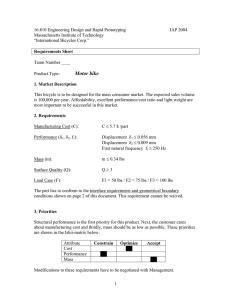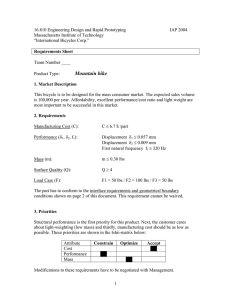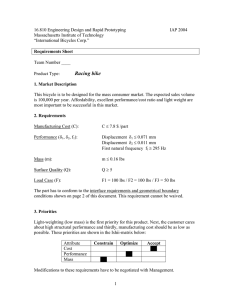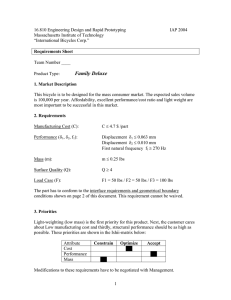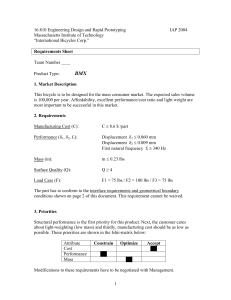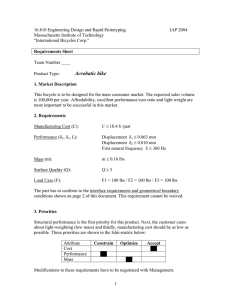Pecan Production 101 Session 2
advertisement
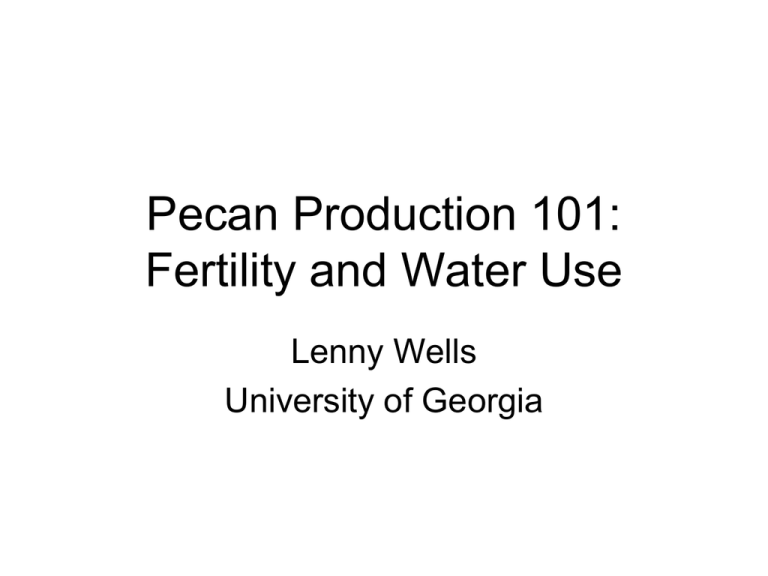
Pecan Production 101: Fertility and Water Use Lenny Wells University of Georgia Leaf Tissue Results Desired Range Mean % Low % High Sample Range Leaf N 2.5-3.3% 2.77% 3 0 2.58-3.09 Leaf P 0.12-0.3% 0.14% 0 0 0.13-0.18 Leaf K1 1.25-2.5% 1.26% 45 0 1.04-1.50 Leaf Ca 1.0-1.5% 1.84% 0 48 1.37-2.36 Leaf Mg2 0.35-0.6% 0.53% 7 0 0.32-0.66 Leaf S 0.25-0.5% 0.24% 3 0 0.22-0.28 Leaf Fe 50-300ppm 71.7ppm 0 0 50-142 Leaf Zn 50-100ppm 125ppm 7 34 41-292 Leaf B 50-100ppm 84ppm 0 20 50-146 Leaf Cu 6-30ppm 9.8ppm 0 0 6-14 Leaf Mn 100-800ppm 562ppm 0 21 190-1251 Leaf Ni ? 2.5ppm ? ? 1-11 1Leaf K recommendations of 0.7-2.5 are adequate for “off” crops, but often inadequate for “on” crops. This is relative to the amount of Leaf N. Soil Sample Results Desired Range (lbs/A) Mean (lbs/A) % Low % High Sample Range (lbs/A) Soil P 30-60 98.3 0 90 48-183 Soil K 60-150 153 0 34 94-361 Soil Ca 400-900 988 3 48 192-2241 Soil Mg 90-100 184 7 90 35-436 Soil S 10-50 26.6 3 0 4-41 Soil Fe 12-25 22.6 3 24 8-76 Soil Zn 15-20 25 28 55 3.9-55.3 Soil B 0.5-1.0 0.99 41 14 0.22-6.0 Soil Cu 0.5-1.5 1.1 14 10 0.2-7.2 Soil Mn 15-40 31.9 28 7 13-45 Soil Ni1 ? 1.26 N/A N/A 1-7 pH 6.5-7.0 5.96 90 0 5.3-7.0 Leaf Sampling • Sample trees between July 7th and August 7th. • Use terminal shoots exposed to the sun. • Collect leaflets from all sides of the tree. • Avoid leaflets damaged by insects and diseases. 40 Soil Sampling • • • • Useful for pH and toxicities Late Fall/Winter Sample uniform area 1 pint/sample (15-20 cores) over large area • Sample to 8” depth Nitrogen • N absorption by roots is driven by demand • Demand is regulated by growth of leaves or fruit, and production of proteins. • Flowers may be aborted if leaf N is deficient the previous summer Nitrogen • Leaf Concentration: 2.5-3.3% • 10 lbs N/100 lbs expected crop • Shoot growth should be 8-12” Nitrogen • In well managed, irrigated orchard soils, applied N can move more readily and leach out of the effective root zone before it is taken up by the tree. • Initial spring N used by developing foliage comes from storage pools within the tree. • N demand will be greatest for “on” trees bearing a heavy crop load, since expanding leaves, shoots, and fruit create the greatest demand. Nitrogen • General Recommendation: • 50-75 lbs N applied mid-late April • Examine Crop in June/July • “On Year”---50-75 lbs applied at end of August/1st Sept. • “Off Year”---0 lbs applied late season OR IF NO AUGUST APPLICATION • 75 lbs N in March/April (March after “on year”) • 25-75 lbs in May/June • Most of the N taken up during the kernel-fill stage will supply the N storage pool needed for early spring growth. • Timing of fertilizer application for non-irrigated or run-down orchards will be different Nitrogen Dry-Land /Neglected Orchards • 75 lbs N in March • 25-50 lbs in late May Young trees • Year 1: 1 lb 10-10-10 fertilizer distributed in a 25 sq. ft. area around the tree (apply in June if growth is good; 2-4’ terminal growth) • Year 2: 1 lb of 10-10-10 fertilizer in March and May. Do not place fertilizer within 12 inches of the trunk • 1 lb zinc sulfate per tree for the first three years following planting. Nitrogen • Fertilizing on a per tree basis – Mature trees • 1 lb amm. Nitrate/inch of trunk diameter in late March before bud break (Max 8 lbs). Water in promptly • If lawn is concern, bore holes in ground and pour in, then water area or • 4 pounds of 10-10-10 for each inch of trunk diameter (measure 4 1/2 feet above soil level) up to 25 lbs/tree. This fertilizer should be applied in late March before bud break. Zinc needs are best determined by analysis of leaf samples taken in late July or early August. (Max 2 lbs/tree) 25 lbs 10-10-10/tree in 25 X 25 ft area = 290 lbs N/acre N-Fertilizer Application in Orchards • Broadcast – Inefficient and expensive • Band – Apply material to active root zone – Cheaper • Fertigation – Total rate (75-100 lbs/A) should be split over 3-4 applications (at 14 to 30 day intervals) – 28-0-0, UAN, Potassium Nitrate, Urea – Watch pH – CaNO3 Clover as a Source of Nitrogen • Crimson – 100 lbs N/A – – – – 15-18 lbs/A drilled 20-30 lbs/A broadcast Plant immed. after harvest ‘Dixie’ • ‘Durana’ White Clover--100 lbs N/A – 2-3 lbs/A seeding rate – Increase broadcast rate by 25% – Perennial • Allow clover to re-seed • Need to keep adequate soil K levels N Credit for Legumes • Crimson Clover – Year 1 = Replaces 30 lbs N/Acre • On Year = 150 lbs N-30 lbs N = 120 lbs N/Acre • Off YEAR= 50 lbs – 30 lbs = 20 lbs N/Acre – After 3 Years = Replaces 75-150 lbs N/Acre • On Year = 150 lbs N – 100 lbs N = 50 lbs N/Acre • Off Year = No additional N required Effect of Clover on Organic Matter and N Sample Site Nitrate-N Organic Matter 4” Sod 3.78 1.34 8” Sod 4.18 1.66 4” Sod+Clover 8” Sod + Clover 13.95 2.32 10.75 2.90 Orangeburg Loamy Sand Problem Weeds in Orchards Utilizing Clover • Rye-grass – Poast Plus = 16 oz./ acre • Wild Turnip • Wild Geranium • Sandea (Halosulfuron-methyl) – – – – Excellent on wild turnips (pre and post-emergence) Good activity on wild geranium Good control of rye-grass Potential Problems: • Cost = $15/acre @ 0.5 oz/acre • Delayed clover development; possible effect on seed viability • Basagran – Cost = $16/acre @ 2 pints/acre – Problems: For use only on Non-Bearing Pecans Wild turnip must be treated up to a weed height of 3” Best results on geranium will be achieved when weeds are small Heavier the Infestation, earlier the treatment Yet To Be Determined: • 2,4-DB-amine – used for the control of many annual and perennial broad-leaved weeds in alfalfa, peanuts, soybeans – Labeled for clover • Timing and rates Uses 5% Roundup solution (1.25 gal.25 gal water) Cost per acre varies with weed density Chicken Litter • Have sample analyzed • Typically: N 60 lbs/A P 60 lbs/A K 40 lbs/A Ca 30 lbs/A Zn 0.6 lbs/A Cu 0.6 lbs/A Nutrients are organically bound • 60% (36 lbs N/ton) is available for crop uptake during the season. • Use BROILER litter and NOT LAYER litter • Ca/Mg *~30% of growers use chicken litter 40% of those who do not, would use it if supply was available Chicken Litter • 1 ton/A of poultry litter -- February • 1 ton applied - May • “On Year” -Additional 50-80 lbs N/A applied as synthetic fertilizer in late August or split between early August and early September Potassium (K) • K is transported to nuts at leaf’s expense • 50-100 lbs K applied in February/March • During “on” year apply additional 30 lbs K in mid to late August • 1.25-2.5 ppm in leaf analysis • Manage N/K ratio to 2:1 • Manage Mg---(No Dolomitic lime above .45% Mg) • Deficiency most common on Desirable and Schley Zinc • Necessary for shoot elongation, leaf expansion, and yield • Apply 50 lbs Zn Sulfate/A when soil Zn is less than 15 lbs/A • 2 lbs Zinc sulfate + 3 lbs Potassium Nitrate/100 gallons • Begin 2 wks after bud-break until shoot elongation complete Boron Recommendations • Can increase fruit retention and kernel percentage • 3 pre-pollination applications of B beginning before catkins are mature • No benefit to making more than 3 applications Flower Cluster Lower B, Ca, Ni, Cu, Fe In young fruit = Predominately phloem mobile nutrients (note B, Ca, Ni, Cu, Fe move poorly in the phloem) = Xylem mobile nutrients (all elements) Xylem connection with young fruit is poor, so can get low Ca and B in fruit Higher B and Ca Note: -Excessive soil Ca can reduce B uptake Leaves So, B, Ca, Ni, Cu, and Fe are relatively low in young fruit even though there is plenty of B and Ca in other tissues and in previous buds. Effect of Boron Sources On Spray Water pH 9 8.5 8 7.5 7 pH 6.5 6 Initial Water pH Boric Acid (Dry) Ultrabor Solubor DF Borosol 10 Solubor WP Boron X-Tra (5 oz/a) Solubor Liquid Bor - N 5.5 5 4.5 4 Product Glenn Harris Boron and pH • Most Liquid Sources of Boron (even Boric acid) will raise pH in the tank mix • Dry formulations of Boric acid tend to lower pH • Depends on the solvent used Why is spray-water pH important? • Alkaline Hydrolysis – detrimental effect of high pH spray water • Imidacloprid, Organophosphate and carbamate pesticides degrade in pH >7. Organophosphates Carbamates • Malathion/Parathion • Sevin •Lorsban •Lannate • Diazinon Nickel • Improves Mouse-ear Symptoms • Effects of Nickel on N metabolism in pecan: • Can influence the efficiency of early spring N conversion and transport within the pecan tree (Bai et al. 2007). • 2 applications: Early to mid April and again 2-4 weeks later Pecan Water Use • Pecans extract most of their water from the upper 32 inches of the soil profile • Need 60” of water per year • Pecans can use as much as 350 gal/day • Greatest demand is during August/September • Drip/Microjet system capacity should be at least 3600 gallons/acre/day • Pecan Irrigation systems are designed to be supplemental to rainfall Pecan Irrigation Schedule Month Drip (%cycle) Sprinkler (inches/A/wk) April 60 0.5 May 70 .75 June 80 1 July 90 1.25 August 100 1.5 September 100 1.5 October 90 1 November 60 0.5 Pecan Irrigation Systems • Solid Set – Expensive – Poor water use efficiency – Water large area quickly • Sprinklers often in every other middle • Pump capacity should be at least 75 gpm/A Pecan Irrigation Systems • Drip – Efficient – Wet small area – Concentrates roots – Compatible with injection of fertilizer and systemics – Labor intensive • May be laid above or below ground • Full cycle should be no more than 12 hrs Drip Irrigation • Lateral lines normally 6-8 ft from tree • Mature orchards need 2 lateral lines/ tree row (both sides of tree) • Most emitters used are 2 gph • 8-16 emitters per tree Pecan Irrigation Systems • Microjet – Same benefits as drip – Larger wetted area – Best system for establishment of young trees 16 gph 16 gph
